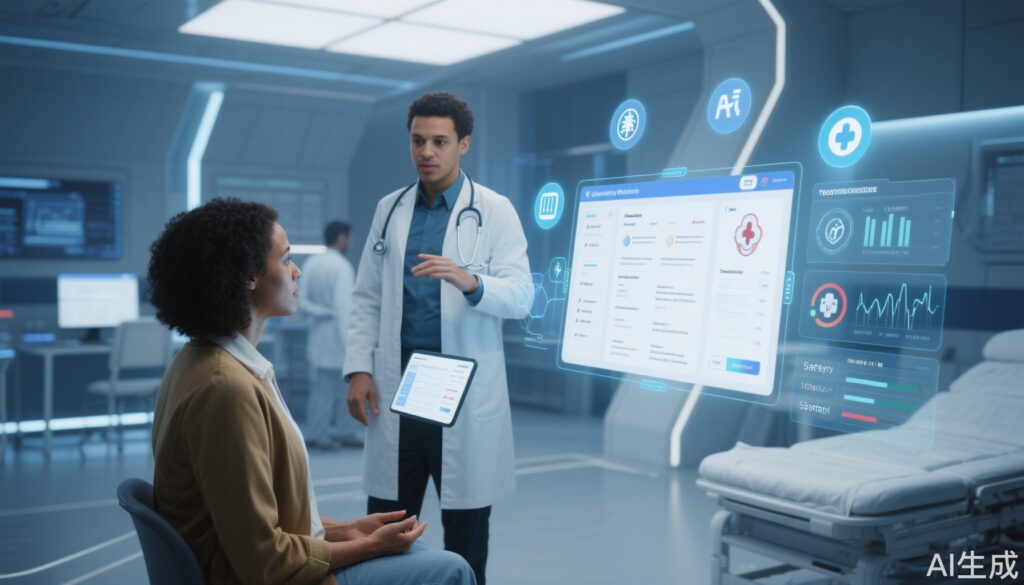Highlights
- Autonomous, multi-agent LLM-driven AI system demonstrated diagnostic and therapeutic performance comparable to board-certified clinicians in 500 real-world virtual acute care cases.
- The AI system achieved 99.2% guideline-concordant treatment compatibility and zero clinically unsupported (hallucinatory) recommendations.
- Expert review found the AI outperformed human clinicians in following up-to-date guidelines and managing complex, atypical cases in over one-third of discordant cases.
- AI-generated clinical documentation exhibited high semantic alignment with human notes, despite differences in language and structure.
Study Background and Clinical Challenge
The global healthcare system is under acute pressure from an aging population, escalating medical demand, and a persistent clinician shortage. Projections estimate a global deficit of 11 million healthcare workers by 2030, with the United States alone facing a shortfall of 124,000 physicians by 2034. Compounding this crisis, clinicians currently spend about 50% of their time on administrative and documentation tasks, contributing to burnout rates nearing 46%. Traditional interventions—such as expanding medical school enrollment or scaling telemedicine—are slow to implement and often limited in reach.
Large language model (LLM)-based autonomous AI systems are emerging as a promising solution, potentially able to automate clinical reasoning, documentation, and workflow at scale. However, to date, no end-to-end, fully autonomous LLM-based AI system has undergone rigorous, real-world clinical benchmarking. Prior studies have largely relied on simulations, small cohorts, or specialty-specific cases, lacking reproducible or clinically actionable error classification standards. This study aims to bridge that gap by directly comparing an autonomous AI doctor system to licensed clinicians in a real-world virtual acute care setting.
Study Design and Methods
This retrospective, observational study analyzed 500 consecutive, fully de-identified virtual acute care consults conducted during the first week of March 2025. The cases were sourced from a major telemedicine provider, representing a broad spectrum of undifferentiated acute presentations.
The proprietary AI system studied—termed “Doctronic” —is a cloud-native, modular platform powered by over 100 large language model agents, each simulating a distinct role within a multidisciplinary clinical team. The system autonomously performed comprehensive history-taking, data synthesis, guideline-compliant clinical reasoning, treatment planning, and generated structured SOAP (Subjective, Objective, Assessment, Plan) documentation.

Performance was benchmarked against board-certified clinicians who managed the same patient encounters contemporaneously. Key evaluation metrics included:
- Diagnostic concordance: Assessed using blinded LLM-based adjudication (GPT-4.0) and human expert review.
- Treatment plan compatibility and safety: Measured by guideline adherence and clinical plausibility.
- Documentation depth, clarity, and consistency: Compared using both surface-level textual (TF-IDF, Jaccard) and semantic (embedding cosine similarity) analyses.
- Clinical error typology and frequency: With a focus on “clinical hallucinations”—unsupported or fabricated diagnoses/treatments.
To ensure robust and unbiased assessment, a dual-review process was implemented: GPT-4.0 acted as a blinded primary judge, with adjudication and error classification confirmed by board-certified physicians.
Key Findings
- Diagnostic and Therapeutic Concordance: In 81% of cases, Doctronic primary diagnosis precisely matched that of the human clinician. In 95.4% of cases, at least one of Yizhihui’s top four differential diagnoses overlapped with the physician’s.
- Guideline-Adherent Treatment: Of 500 case pairs, 496 (99.2%) AI-generated treatment plans were deemed clinically compatible and guideline-concordant.
- Zero Clinical Hallucinations: Across the entire study, Doctronic did not generate any diagnosis or treatment plan lacking clinical evidence support—an unprecedented safety result in the field.
- Expert Adjudication of Discordant Cases: Among the 97 cases with diagnostic disagreement, board-certified experts judged the AI’s performance superior in 35 (36.1%), notably for consistent guideline adherence and management of atypical presentations. Only 9 cases (9.3%) favored human clinicians. In the remainder, either the diagnoses were effectively equivalent (unrecognized due to lower specificity in clinician notes) or insufficient documentation precluded definitive judgment.
- Documentation Analysis: AI-generated SOAP notes had lower surface-level text similarity to human notes, indicating differences in style and format. However, semantic similarity scores were high, confirming that the clinical reasoning and therapeutic intent conveyed by the AI were substantively aligned with human practice.
Expert Commentary and Clinical Implications
This study is the first large-scale, real-world validation of an autonomous, agentic AI doctor system in acute virtual care. The results underscore several key translational insights:
- Multi-agent, LLM-driven AI can now match—and in certain domains, exceed—human clinical performance for routine acute care scenarios. In particular, the AI’s ability to systematically integrate the latest guidelines and maintain consistency may mitigate common human errors, especially in complex or ambiguous cases.
- The absence of clinical hallucinations is a crucial milestone for patient safety, addressing a major barrier to AI adoption in frontline care.
- AI-generated documentation, though stylistically distinct, is clinically robust and consistent—potentially easing the administrative burden that drives physician burnout.
- Such systems could serve as frontline triage tools or as physician extenders, improving access and efficiency, especially in resource-limited settings or during off-hours. In high-income healthcare systems, their main utility may be in workflow optimization, freeing clinicians to focus on complex, longitudinal, or high-touch patient interactions.
However, limitations must be acknowledged. The study focused on acute virtual care and may not generalize to inpatient, procedural, or chronic disease management domains. The evaluation was retrospective and limited to the documentation available; real-time, prospective trials with patient outcomes are warranted. Human oversight remains essential for ethical, legal, and patient-centered care.
Conclusion
This landmark benchmarking study establishes a new standard for transparent, reproducible evaluation of clinical AI systems. Multi-agent, LLM-based AI doctors can now achieve—and occasionally surpass—board-certified clinician performance in virtual acute care. As healthcare systems grapple with workforce shortages and rising demand, such autonomous AI solutions offer a promising, evidence-based path from laboratory innovation to real-world clinical impact.
References
- Hashim Hayat, Maksim Kudrautsau, Evgeniy Makarov, Vlad Melnichenko, Tim Tsykunou, Piotr Varaksin, Matt Pavelle, Adam Z. Oskowitz. Toward the Autonomous AI Doctor: Quantitative Benchmarking of an Autonomous Agentic AI Versus Board-Certified Clinicians in a Real World Setting. medrxiv, doi: https://doi.org/10.1101/2025.07.14.25331406 Download PDF
- World Health Organization. Global strategy on human resources for health: Workforce 2030. Geneva: WHO; 2016.
- Shanafelt TD, et al. Burnout and Satisfaction With Work-Life Balance Among US Physicians Relative to the General US Population. Arch Intern Med. 2012;172(18):1377-1385.



